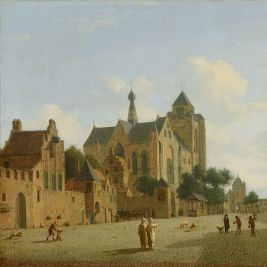
Architecture is an ancient art of creating magnificent monumental masterpieces
Architecture (from the Greek words "αρχι" meaning "chief" and "τέκτων" meaning "builder") is an ancient art of designing and constructing various buildings and structures. Architecture is simultaneously a complex scientific discipline that solves the task of creating a spatial environment for comfortable human habitation. Constructed objects must not only fulfill their intended purpose and be beneficial to humans, but they are also subject to numerous technical and aesthetic requirements. They must be sturdy, durable, and have an attractive appearance.
 Architecture. Taj Mahal Mausoleum in India, 17th century
Architecture. Taj Mahal Mausoleum in India, 17th century
In Russian, architecture is also referred to as "zodchestvo" as an alternative name. This term is usually used to refer to ancient objects constructed by masters from stone or wood.
 Architecture. Pyramid of Kukulkan in Mexico, 8-12th centuries
Architecture. Pyramid of Kukulkan in Mexico, 8-12th centuries
Characteristics and Main Areas of Architecture
Alongside literature, architecture belongs to the realm of static expressive forms of art. Unique architectural masterpieces from past eras primarily serve an aesthetic function in our present-day.
 Architecture. Blue Mosque in Istanbul, 17th century
Architecture. Blue Mosque in Istanbul, 17th century
The finest examples of "zodchestvo," along with paintings and sculptures, form the basis of the world's artistic heritage. Considerable resources are allocated by government bodies and wealthy patrons for the preservation and restoration of ancient architectural objects.
One of the most important tasks in the construction of a beautiful building or structure is to ensure overall unity and harmony in architectural composition. This requires adhering to optimal proportions and scale, principles of symmetry and asymmetry, as well as skillfully employing the advantages of contrast and other nuances.
 Architecture. Parthenon in Athens, 5th century B.C.
Architecture. Parthenon in Athens, 5th century B.C.
Depending on the object of activity, the following areas of architecture are distinguished:
- Structural design. Deals with the construction of individual buildings and structures.
- Urban planning. Addresses the challenges of comprehensive city planning as cohesive architectural ensembles.
- Landscape architecture. Intended for the design and creation of the spatial environment surrounding buildings and structures.
- Interior architecture. Focuses on designing the interior spaces of buildings.
 Architecture. Pyramids of Giza in Egypt, 26th-23th centuries B.C.
Architecture. Pyramids of Giza in Egypt, 26th-23th centuries B.C.
In our time, architects specialize in specific fields even during their education at universities. Some dedicate themselves to building design, others engage in urban planning, while others pursue landscape or interior design.
 Architecture. Landscaping of the Palace of Versailles, 17th century
Architecture. Landscaping of the Palace of Versailles, 17th century
But in European history, there are unique individuals who not only meticulously developed but also brought to life grand architectural projects. The greatest geniuses of the Renaissance era, Michelangelo, Raphael, and Leonardo da Vinci, also achieved worldwide recognition in the fields of painting and sculpture.
History of Architectural Development and Main Styles
The history of architectural development spans a vast period of over 8,000 years. Archaeologists have discovered the ruins of the oldest architectural structures from the Neolithic era dating back to the 6th millennium BCE.
Over many millennia, ancient civilizations emerged, flourished, and disappeared in various corners of the world. Each of them made significant contributions to the development of the art of building and construction.
 Architecture. Alhambra palace complex in Seville in Moorish style, 14th century
Architecture. Alhambra palace complex in Seville in Moorish style, 14th century
Unique architectural styles emerged under the influence of climatic, religious, and cultural factors in different regions. Based on these characteristics, one can distinguish ancient ethnic architectural styles such as:
- Sumerian.
- Assyrian.
- Ancient Egyptian.
- Ancient Greek.
- Ancient Roman.
- Byzantine.
- Moorish.
- Chinese.
- Japanese.
- Indian.
- Persian.
- Ancient Russian.
- Mayan.
- Incan.
- Aztec.
 Architecture. St Basil's Cathedral in Moscow in the Ancient Russian style, 16th century
Architecture. St Basil's Cathedral in Moscow in the Ancient Russian style, 16th century
In the early 10th century, conditions were ripe in Europe for the emergence of the first unified architectural style, the Romanesque style. Its emergence was driven by the widespread spread of Christianity in the Old World. Catholic churches in a uniform style began to be constructed extensively in different regions of Europe. Following them, the dominance of the new architectural direction was manifested in the construction of castles and palaces for the nobility.
 Architecture. Romanesque Basilica of San Piero-a-Grado in Pisa, 10th century
Architecture. Romanesque Basilica of San Piero-a-Grado in Pisa, 10th century
For two centuries, the Romanesque style firmly held its position, but in the early 12th century, it gave way to Gothic architecture. Magnificent cathedrals of that era have survived to this day:
- Cologne Cathedral.
- Reims Cathedral.
- Amiens Cathedral.
- Rouen Cathedral.
- Chartres Cathedral.
- Notre-Dame Cathedral of Paris.
 Architecture. Reims Cathedral in Gothic style, 13th century
Architecture. Reims Cathedral in Gothic style, 13th century
The Renaissance era, which replaced the period of Gothic art in the early 15th century, gifted the world with numerous magnificent examples of Italian architecture. The history preserves the names of the best Renaissance architects:
- Filippo Brunelleschi.
- Michelozzo di Bartolomeo.
- Leon Battista Alberti.
- Donato Bramante.
 Architecture. Filippo Brunelleschi. Florence Cathedral in the Renaissance style, 15th century
Architecture. Filippo Brunelleschi. Florence Cathedral in the Renaissance style, 15th century
In the late 16th century, the architectural traditions of the Renaissance were complemented by more elaborate forms in the whimsical Baroque style. Among the most famous masters of that era, Giovanni Lorenzo Bernini stands out as the author of the design of St. Peter's Square in the Vatican.
Baroque dominated in most European countries for almost 200 years. Magnificent palace ensembles in St. Petersburg were built in this style, as well as a vast number of Catholic cathedrals in Italy, Austria, and Germany.
 Architecture. Baroque Royal Palace in Madrid, 18th century
Architecture. Baroque Royal Palace in Madrid, 18th century
In the early 17th century, a light and playful Rococo style emerged in France, characterized by maximum decorative effect. Distinctive stylized shells appeared in the window openings, and facades began to be abundantly adorned with figurative stucco work.
 Architecture. Rococo Amalienburg Palace near Munich, 18th century
Architecture. Rococo Amalienburg Palace near Munich, 18th century
During the greater part of the 18th century, Rococo competed with Baroque for dominance in the field of architecture but did not achieve the same popularity. This style was mainly used for small palaces and regional rulers' basilicas in Europe.
By the mid-18th century, attitudes towards Baroque and Rococo began to change in all artistic spheres. The excessive whimsicality of forms started to irritate society, and there arose a need for stricter architectural compositions. The birth of Neoclassicism marked a return to the ancient foundations of design - simplicity, harmony, and logical clarity.
 Architecture. Classicist Grand Theatre in Warsaw, 19th century
Architecture. Classicist Grand Theatre in Warsaw, 19th century
In the first third of the 19th century, mass construction of public buildings began, including theaters, museums, libraries, and hospitals. Large urban development projects were implemented, and the central parts of cities were organized. Neoclassicism was perfectly suited for solving these large-scale tasks.
Its pinnacle of development was the birth of Empire style, a grand ceremonial architectural style during the reign of Napoleon Bonaparte. Besides France, the Empire style also gained significant popularity in the Russian Empire.
 Architecture. Arc de Triomphe on Place Carrousel in the Empire style in Paris, 19th century
Architecture. Arc de Triomphe on Place Carrousel in the Empire style in Paris, 19th century
The mid-19th century marked the birth of two new architectural directions: Historicism and Eclecticism.
Supporters of Historicism sought to return to the origins of ancient architectural styles and creatively enhance them with certain details. As a result, numerous diverse sub-styles of Historicism emerged:
- Neo-Romanesque.
- Neo-Gothic.
- Neo-Renaissance.
- Neo-Moorish.
- Neo-Greek.
- Pseudo-Russian.
- Neo-Baroque.
 Architecture. Westminster Palace in neo-Gothic style in London, 19th century
Architecture. Westminster Palace in neo-Gothic style in London, 19th century
Almost simultaneously with Historicism, Eclecticism began to rapidly gain popularity, characterized by the blending of various styles in building design. The ideas of this movement were often used in the construction of public buildings, especially shopping arcades and train stations.
 Architecture. Eclectic-style St Augustin Church in Paris, 19th century
Architecture. Eclectic-style St Augustin Church in Paris, 19th century
At the turn of the 19th and 20th centuries, the architectural style of Art Nouveau emerged, with the famous Eiffel Tower considered as its iconic symbol. Builders began to extensively use new materials such as concrete, glass, metal, and reinforced concrete.
Art Nouveau fully met the demands of an industrial society. Great attention was paid to the comfort of living in building design, and the use of revolutionary building materials allowed for the construction of multi-story buildings.
 Architecture. Sagrada Família Church in Barcelona in Art Nouveau style, 19th century
Architecture. Sagrada Família Church in Barcelona in Art Nouveau style, 19th century
In the architecture of Art Nouveau, the works of the genius Spanish master Antoni Gaudí stand out. His unique architectural masterpieces are rightfully considered the hallmark of Barcelona and attract millions of tourists to the capital of Catalonia every year.
 Architecture. Architectural ensemble in the Constructivist style in Kharkov, the 20th century
Architecture. Architectural ensemble in the Constructivist style in Kharkov, the 20th century
Even more revolutionary in the early 20th century was the phenomenon of Modernism in architecture. This powerful movement encompasses several distinct styles:
- Constructivism.
- Rationalism.
- Functionalism.
- Brutalism.
- International Style.
- Organic architecture.
 Architecture. House over a waterfall in the style of organic architecture, 20th century
Architecture. House over a waterfall in the style of organic architecture, 20th century
Common trends for all of the above movements can be characterized by a rejection of facade ornamentation and the use of steel structures (frameworks). Numerous industrial buildings and skyscrapers in American metropolises were constructed following this principle. The ideas of Modernism also found vivid expression in the standardized urban development of Soviet cities during the reigns of Khrushchev and Brezhnev.
The excessive rationality and functionality of modernism led to large cities losing their unique character. Monotonous multi-story buildings evoked a sense of monotony among residents and gradually started to repel people. There arose a need for new architectural ideas, and thus postmodernism emerged.
Its proponents were determined to bring artistic imagery and originality back to buildings. They began to borrow aesthetic principles from ancient styles, imitate historical monuments, and actively use decoration in façade embellishments. Postmodernists rejected the austerity and stereotypical forms, aiming to consider the characteristics of the urban environment in building design.
 Architecture. PPG Place building in Pittsburgh in the postmodernist style, 20th century
Architecture. PPG Place building in Pittsburgh in the postmodernist style, 20th century
In the late 20th century, with the emergence of three new styles, grand prospects for realizing revolutionary ideas in the field of architecture opened up:
- High-tech.
- Bio-tech.
- Deconstructivism.
High-tech absorbed the fundamental principles of modernism (rationalism and functionality) and added technological features to buildings. This style did not gain many followers and was hardly used in construction for nearly 20 years. However, high-tech became a highly popular direction in interior design among the wealthiest and most successful individuals of contemporary times.
 Architecture. HSBC high-tech building in Hong Kong, 20th century
Architecture. HSBC high-tech building in Hong Kong, 20th century
Bio-tech, or architectural bionics, is essentially the opposite of high-tech. It strives for harmonious unity between the built environment and nature. Building silhouettes have biomorphic structures, and only environmentally friendly forms of energy are used to support human activities.
 Architecture. National Space Centre of Great Britain in bio-tech style, 20th century
Architecture. National Space Centre of Great Britain in bio-tech style, 20th century
Deconstructivism is a contemporary architectural style characterized by curved or angular forms. Buildings, at first glance, appear to embody controlled chaos and have extremely unconventional outlines. A prominent representative of deconstructivism is the internationally renowned British artist of Arab origin, Zaha Hadid.
 Architecture. Zaha Hadid. Deconstructivist Heydar Aliyev Centre in Baku, 20th century
Architecture. Zaha Hadid. Deconstructivist Heydar Aliyev Centre in Baku, 20th century
Architecture is an important part of human society that surrounds us everywhere. Talented architects throughout history have brought to life not only comfortable living spaces but also unique masterpieces of monumental art.
 Architecture. St Peter's Cathedral in Vatican, 16th century
Architecture. St Peter's Cathedral in Vatican, 16th century
On the Very Important Lot portal, every visitor can participate in art auctions to acquire unique antique masterpieces online. Our website also offers everyone the unique opportunity to purchase paintings and interior items directly from contemporary artists.

 Still life is a genre of painting that perfectly reflects the artist's inner universe
Still life is a genre of painting that perfectly reflects the artist's inner universe  The painting "La Promenade" by Pierre-Auguste Renoir is an example of fleeting happiness
The painting "La Promenade" by Pierre-Auguste Renoir is an example of fleeting happiness  Surrealism is art from the depths of the human subconscious
Surrealism is art from the depths of the human subconscious  Modern - breakthrough or just a transitional period
Modern - breakthrough or just a transitional period  Meissen Porcelain: The History of the Manufactory
Meissen Porcelain: The History of the Manufactory  Orders of France - from the Middle Ages to the present day
Orders of France - from the Middle Ages to the present day  Silver - a noble metal
Silver - a noble metal  Pablo Picasso was a recognized genius of 20th-century art
Pablo Picasso was a recognized genius of 20th-century art  Figurative art and figurativism are antipodes of abstractionism and conceptualism
Figurative art and figurativism are antipodes of abstractionism and conceptualism  The Order of St. Patrick is the most prestigious Irish distinction
The Order of St. Patrick is the most prestigious Irish distinction